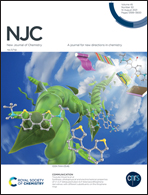Effect of diatomite addition on crystalline phase formation of TiO2 and photocatalytic degradation of MDMA†
Abstract
In the present study, titanium dioxide nanoparticles (TiO2NPs) were immobilized on Algerian diatomite surface by simple sol–gel method for improving the photocatalytic efficiency of TiO2. A series of composites TiO2/diatomite (TiD) was synthesized with different amounts of diatomite and TiO2 NPs composed of mixed rutile/anatase phase for the photodegradation under UV-irradiation of 3,4-methylenedioxymethamphetamine (MDMA), otherwise known as Ecstasy. This illicit drug is the most consumed among adolescents and identified in wastewater effluents. The effect of diatomite addition on formation of crystalline phase, crystallite size and porosity was investigated. The results showed that the rutile/anatase phase ratio in TiO2NPs can be controlled through the diatomite addition. Morphological and structural characterizations of the prepared composites have been carried out by using X-ray diffraction (XRD), X-ray Fluorescence (XRF), Nitrogen sorption at 77 K, scanning and transmission electron microscopy (SEM and TEM, respectively), energy dispersive X-ray spectroscopy (EDS) and ultra-violet reflectance diffuse spectroscopy. All prepared composites TiD displayed a remarkable enhancement of the photocatalytic activity compared to pure commercial and synthesized TiO2. The composite which contains a mixed phase rutile/anatase (at 42 : 58 weight or molar ratio) and SiO2 content of 20 wt% exhibits the best and the highest photocatalytic activity in the degradation of MDMA.



 Please wait while we load your content...
Please wait while we load your content...